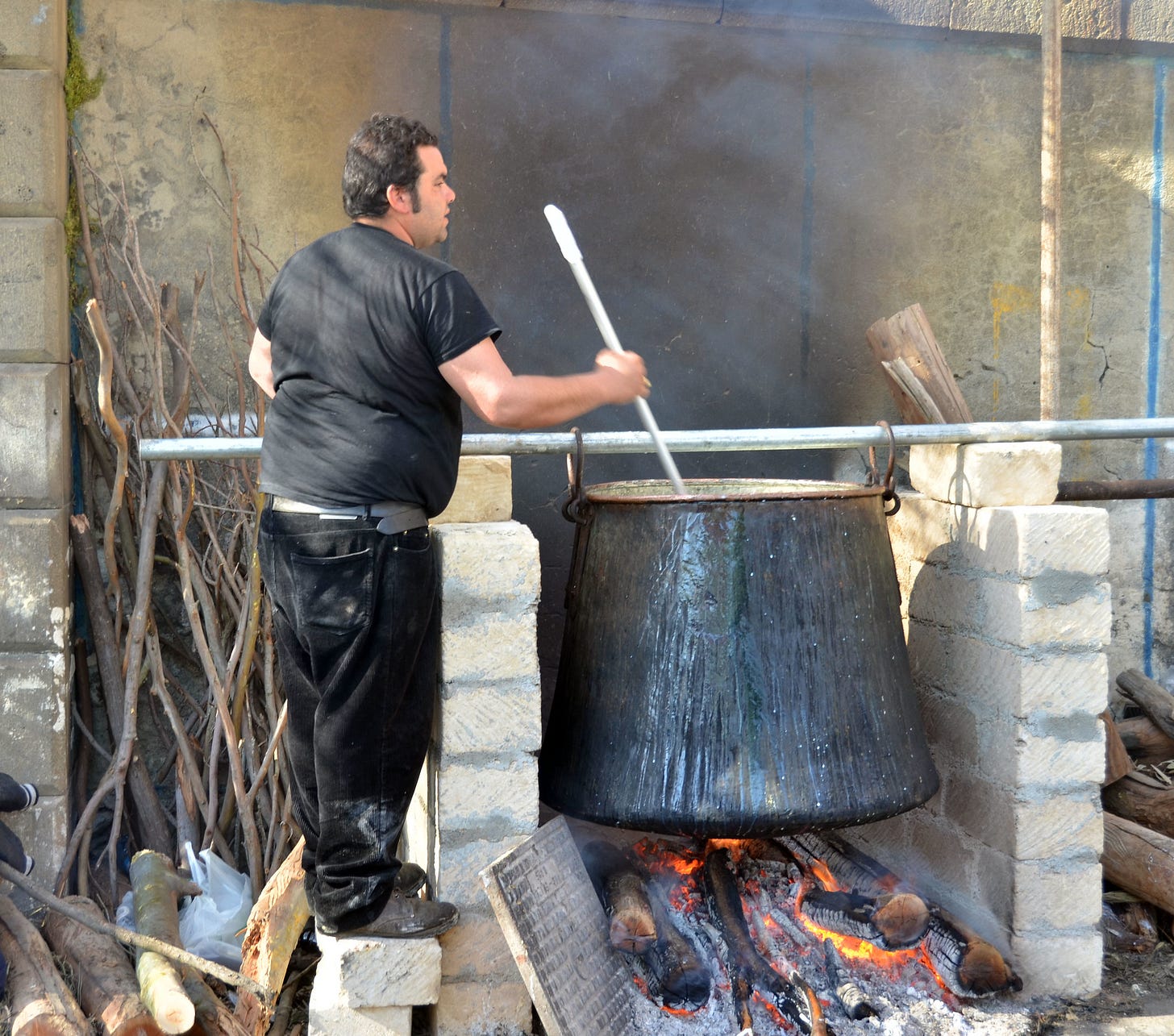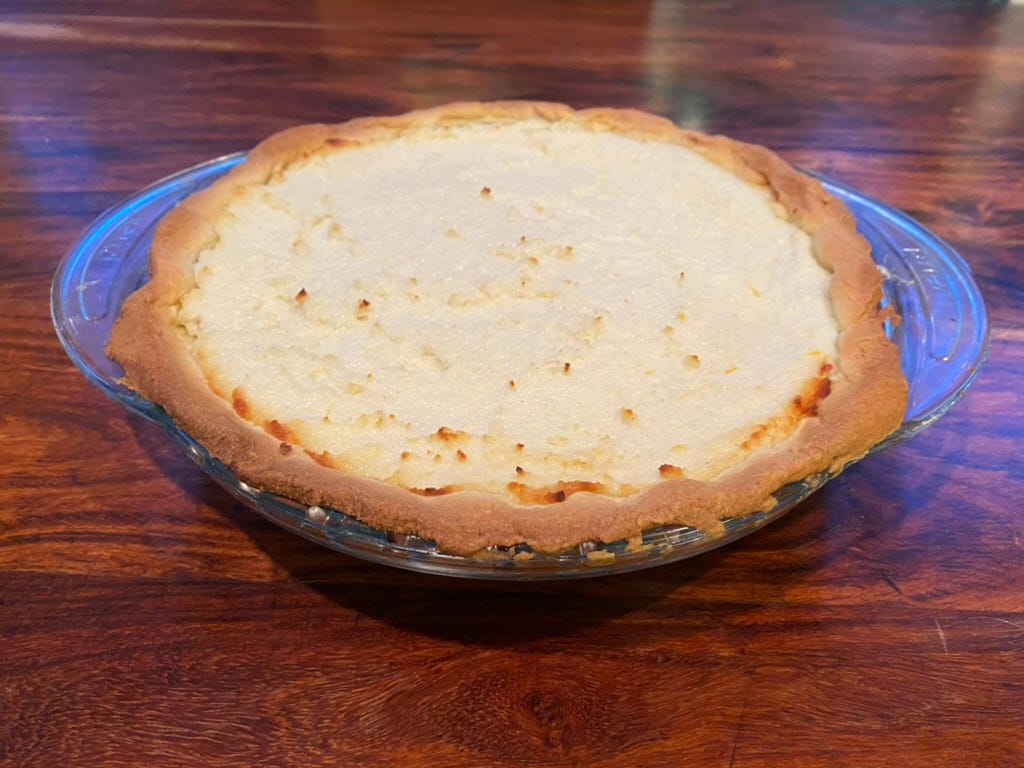Cassata, the ancient Sicilian Easter dessert you can make this week
Don't sleep on the opportunity to feast like a cyclops this Easter.
In our family, Easter means many things, but as far as desserts go, it means cassata. This Easter pie, made with sweetened, scented ricotta cheese, is about as rustic and simple as it gets, but it is so beloved and delicious that we look forward to it all year long. I’ll explain.
First of all, there are two desserts in Sicily called cassata. The more famous of the two is traditional to the Western side of the island, where the Moorish influence was strongest. Cassata Siciliana, as it is called, is a layered dessert of sponge cake soaked with Marsala wine, sweetened ricotta cream, chocolate chips, and candied fruit encased in a fondant-like casing of green marzipan. It’s as complex, rich, and spectacular as it sounds, and it is a triumph when served in the bakeries of Palermo.
But that’s not our cassata.
My family, who hails from the Greek-influenced Eastern side of the island, and who were much more rural than the urban Palermitani, eat the other kind of cassata, the cassata rustica or “country cassata”. This is the older of the two types, and the simpler: it’s just sweetened ricotta cheese, scented with a bit of lemon, baked in a butter and wheat flour crust. And its roots go back about as far as a dish can get, to the earliest days of cooking and food.
The main ingredient of cassata is ricotta cheese, which also gives the name to the pie. In the ancient Latin language, the word for cheese was caseus, and this led to the baked cheese pie being called caseata. Over the years, this became the Sicilian word cassata. But it’s not just any cheese- cassata requires ricotta cheese, which is different. Without getting too complex, ricotta is a cheese that is made from the leftovers of…. making cheese. When sheep’s milk cheese (pecorino) is made in the traditional Sicilian way, it is rich and delicious, but it leaves some milk solids behind- a no-no to the thrifty Sicilian peasant. By “re-cooking” the whey, you can make a second batch of fresh, tender, sweet cheese. This “recooked” cheese (ri-cotta in Sicilian) became a hallmark of Sicilian peasant cooking (the cheese could be sold, but the ricotta would be eaten at home).
Sicilian ricotta was famous even in antiquity. The technique for making it was probably invented in the bronze age, out of the reach of our histories. But in Homer’s Odyssey, he was careful to mention that the Cyclops Polyphemus- who lived on the island of Sicily- made sheep’s milk cheese, pouring the curd into baskets, just as Sicilian ricotta-makers do. Ancient Greeks used the word trophalis (τροφαλίς) to describe a tender, fresh cheese that was, in the ancient food writer Athenaeus’ words, “The glory of fair Sicily”. Trophalis, in Greek, means something like “nourishment”, suggesting that this was a basic foodstuff of the Sicilians.
By the 13th century, European translations of the Arabic medical treatise Tacuinum Sanitatis included ricotta in its description of essential medieval foods.

Sicily is still famous for its ricotta, and it features in many of the island’s classic dishes- from ziti al forno to pasta alla Norma. Ricotta is still “nourishment” for Sicilians, and we treasure it.
Ricotta making is a classic springtime activity. Springtime is when sheep bear lambs, and so sheep’s milk is abundant in the spring. The ancients made lots of ricotta in the spring, then learned to sweeten it, add egg, and bake it into a short crust like a pie. It only makes sense that such a springtime dessert would become associated with Easter celebrations, along with roasted lamb and hard-cooked eggs. My Easter table always features this ancient dessert, and I serve it with fresh fruit and Easter cookies. Sicily’s Mediterranean neighbors serve a similar pie- in Spain, quesada pasiega is the sibling of cassata, and in Greece they make melitinia, an Easter pie almost exactly like cassata. Good ideas travel I suppose.
My recipe for Giuliano-style cassata is below. Buona Pasqua!
Cassata
Crust (pasta frolla)
3-3.5 cups flour
1/4 lb., butter
3/4 cups sugar
3 eggs
3 teaspoons baking powder
2 teaspoons vanilla extract
This is the all-purpose pasta frolla (short crust) used everywhere in Sicilian baking. Mix 3 cups flour (reserve a half cup for dusting and adjustment), room temperature butter, sugar, eggs, baking powder, and vanilla extract in a mixer or by hand. Knead until it resembles clay (like play dough) adding flour if necessary. Wrap in plastic and set in the refrigerator until well chilled, at least an hour or overnight. This dough is easily frozen, too.
When it’s time to make the cassata, find a large pie plate, and roll out the dough to make an open-crust pie. Trim and pinch the edges but not too thin. This is a rustic pie.
When the crust is ready, prepare the filling.
Filling
2 lbs ricotta (a note on ricotta: regular supermarket ricotta is often grainy and pasty. Try to get ricotta from an Italian grocery or, better still, make your own: there are lots of instructions on the internet).
1/2 cup sugar
2 eggs
1/4 teaspoon cinnamon
1/4 teaspoon lemon rind or lemon extract
1/4 teaspoon vanilla extract
Beat all the ingredients together until smooth, making sure all the ricotta curds are small. Pour evenly into the crust, spreading to smooth with a spatula if necessary.
Bake in a 350 degree oven for one hour. I protect the crust with some foil, which prevents it becoming overbrown. The cassata is ready when a toothpick inserted in the pie comes out clean.








I love this dish and would gladly choose it over a much sweeter cheesecake. But I didn’t love desserts like this when I was a kid. Is there tasting science about how our tastes for less sweet desserts change as we age?
As “quesada” and “cassata” have exactly the same etymology (“cheesed”), “quesadilla” in Sicily would be “cassatella” 😃